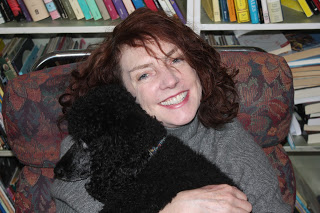 |
| Photo of Franny by Miranda Pettengill |
Franny Billingsley writes fantasy novels for young-adult and middle-grade readers.
Her most recent novel is Chime (Dial, 2011), a National Book Award Finalist. She was on the faculty of Vermont College of Fine Arts until the summer of 2012, when she moved to Mexico.
She now works with private students and offers a semester of private study, modeled on the low-residency MFA programs, in addition to manuscript critiques. In addition, Franny has a particular interest in speaking to school groups in Texas. To contact Franny, please email frannybillingsley@gmail.com.
I’d planned to begin by quoting Henry James on the plot-character connection, but I soon realized I’d better clarify something: Henry James isn’t the old dog I refer to above. I am. I’m old and I’m dogged—old enough to have first read the James quote about twenty years ago, dogged enough to have explored it ever since.
Here, then, are James’s famous words. “What is character but the determination of incident? What is incident but the illustration of character?”
Over the years, I’ve developed a schema that helps me analyze the plot-character connection. It examines, among other things, the character’s “controlling belief,” which is what the character believes about herself and/or about her world. It’s best illustrated by example.
Let’s look at Briony, the protagonist of my most recent novel, Chime (Dial, 2011). Let’s look at her history.
She was led to believe she’s a witch. She was led to believe that in a fit of jealousy she called upon her witchy powers and injured her sister. It is Briony’s history that gives rise to her controlling belief, which is that she’s wicked, dangerous, cold.
Briony not only filters her view of the world through the lens of this belief, she acts on it: Her controlling belief (character) drives the narrative (plot).
So here I am, the old dog, gnawing on the plot-character bone. What, then, is the new trick?
About six months ago, I worked on a YA fantasy with a student who’d used my schema to analyze her character. She had a pretty good bead on her character’s controlling belief and how it shaped the plot, but there was something about the manuscript that eluded me. There was something about the crisis moment that wasn’t quite working.
I chewed on it, and slept on it, and one morning I awoke with an idea.
What if, in the crisis moment, the character were to act against her controlling belief? That could be a powerful turning point in a novel, moving the plot ahead while showing how the character has changed.
 |
| Franny’s bookcases |
I then realized that Briony does exactly that. I hadn’t planned it—some sense of structural rhythm must have led me there—but indeed, in the crisis moment of Chime, Briony does act against her controlling belief. It’s a strong plot development; I’ve since come to think it’s a big part of what makes the novel work.
To explain: In the chapters leading up to the crisis, Briony is forced to reveal she’s a witch. This revelation, in turn, forces her to flee her village—if she’s caught, she’ll be hanged. But her path intersects with that of the romantic hero, who’s been mortally wounded. She could leave him to die or she could take him back to the village and save him. If she listened to her controlling belief (Wicked! Selfish!), she’d leave him to die. But instead, she takes him back to the village, where (as she thinks) she’ll be hanged.
As it turns out, it’s this very action that unlocks the truth about her past.
During the last six months, while I’ve been learning this new trick, I’ve also been working on my new novel. But it wasn’t until this past week (while I’ve been writing this guest post) that I realized something kind of horrifying: I haven’t thought about whether I should turn my new character against her controlling belief. I haven’t contemplated it for even a second.
So I played out the possibility: Yes, good things would happen if my character were to act against her controlling belief. Well, they’d be bad for the character but good for the story.
 |
| The door to Franny’s study |



Great post! Sounds like it'd be something good to do during a round of revisions, checking if the character's controlling belief is tied to their actions.
Ever since you first explained controlling belief in your summer 2010 VCFA lecture, I have defined the controlling beliefs of each of my main characters, printed them, and set them up under my screen as a constant reminder. Keeping track of the controlling belief is such a smart idea, Franny! Thanks for it–and all of your other lessons.
P.S. I love your library.
I read Chime and loved it. It's wonderful to hear from Franny about how Briony went against her long-held beliefs, which created a major turning point. I'm even happier I read the book because I can now see how well this worked in the story. I am going to explore this idea in my own writing. Thank you, Cyn and Franny!
Lynne, yes, definitely one of those questions to ask ourselves. For some, as a threshold consideration, for others, as a revision issue.
Sandra, I wish I'd been at that lecture. Sounds wonderful.
Theresa, Chime is a model for study, to be sure.